Edinburgh is one of Europe’s top visitor destinations and we have had many people ask ‘I only have one day to spend in Edinburgh – what should I see?” In many cities it would be virtually impossible to take in the main sights in one day without taking an open top bus tour or a handy TARDIS. But this one day itinerary will give you an excellent introduction to the city. This route took a little over 2 hours to walk in total – not including stops so you will need to factor in how much time you want to spend at each location, because the route is a pinched loop its even possible to split over two days if you prefer to see everything – I’ve pointed out any museums and other attractions on the way so its up to you which ones you want to skip.
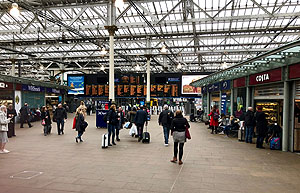
I’ve based this route on a visitor arriving by train – the tram and bus connections from the airport come close too but for me there is something magical about arriving in Edinburgh by train – especially from the west, after leaving Haymarket station (the last but one coming from the West) the train enters a series of tunnels – emerging for a moment in the city centre where you catch tantalising glimpses of the castle and gardens before diving into darkness once more to emerge at Waverley station.
Once you have disembarked look for the exits – there are a few ways out of the station; most people make for the escalators and stairs heading up towards Princes St. Don’t do this, instead look for the ramp that heads up out of the station to the left of the stairs (to the right of the main concourse as you look at the destination boards) This used to be the main roadway into the station. I love coming back into Edinburgh this way because the city slowly reveals itself as you emerge above ground. In my honestly unbiased view (really) it has to be one of the most dramatic entrances to a city in the world.
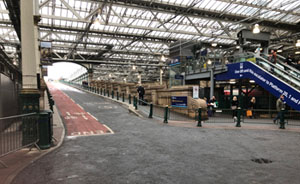
1. Princes St Gardens
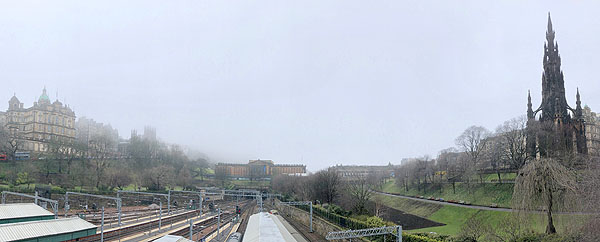
You will emerge onto Waverley Bridge. This is where most of the tour buses and the airport link buses stop – avoid the temptation of the open top tour bus and head across the road (the crossing is up on your right). Avoid walking along Princes St which is a tangle of the usual department stores on one side, instead go through the gates and into the gardens.
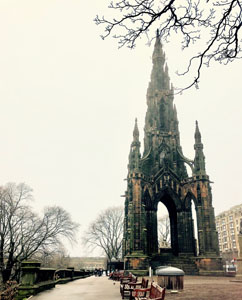
Princes St Gardens has two distinct parts; the East and West Gardens – entering at the East gardens you will be making your way West. By now it’s impossible to miss the massive monument dead ahead of you – The Scott Monument (or ‘The Gothic Rocket’ to the locals) is an imposing spire housing a white marble statue of Sir Walter Scott at its base. At a shade over 200 feet high it is the tallest monument to a writer in the world. Another interesting fact is that the designer of the monument; George Meikle Kemp was a self taught architect and joiner who entered the competition under an assumed name for fear that his lack of experience would count against him. The monument is open all year round and a series of ever narrowing spiral stairs can you take you close to the top with excellent views across the city. Personally I would maybe leave that to the end if you have time and energy left – there are better vantage points to come…
On your left you will see the large dome of the Bank of Scotland’s old headquarters and the spires of the General Assembly building’s of the Church of Scotland – this gently sloping horizon full of chimney tops and spires is the Royal Mile where you will be heading to later (but not now) Instead keep going through the gardens to emerge at “The Mound”
The two impressive classical buildings now in front of you are the Scottish National Gallery on the left and the Royal Scottish Academy on the right. The Scottish National Gallery houses the permanent collection of Fine art (excluding modern art which is housed elsewhere). and the Royal Scottish Academy has a rolling schedule of temporary exhibitions of contemporary art by mostly Scottish artists. Both the Society of Scottish Artists and Royal Scottish Academy have regular exhibitions through the year. If you are visiting in the tourist seasons the open square in front of both buildings will be busy with street performers of vendors of all sorts – its a wonderful public space and if not too crowded look for the bronze 3D map of the centre which will help you understand the city’s complex layout. For now, head past these buildings and cross over top the next part of the gardens.
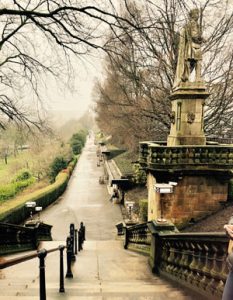 At the entrance to the gardens a set of steps descend – just to the right you might be lucky to see the ‘Floral Clock’ on display. Designed in 1903 it was the first floral clock in the world with both working hands and the mechanisms that runs the clock is hidden in the plinth of the nearby statue of Alan Ramsay.
At the entrance to the gardens a set of steps descend – just to the right you might be lucky to see the ‘Floral Clock’ on display. Designed in 1903 it was the first floral clock in the world with both working hands and the mechanisms that runs the clock is hidden in the plinth of the nearby statue of Alan Ramsay.
Our route now takes you down into the gardens again. Had you been walking along this way before 1820 you would now be either very wet or underwater as this was the site of the old Nor Loch. This area on front of the Castle was originally a marsh. In 1460 King James III ordered it to be filled in with water to improve the castle defences. as the city grew around the castle at an accelerated rate the loch became one massive open sewer as everything (and i mean everything) that ran from the growing city ended up here (this also included public executions by drowning). As you wander along the gardens you will also be treated to that classic view of Edinburgh Castle (which we didn’t today as it was lost in the mist).
Along this stretch there are a few monuments that will be of interest to visitors: The impressive kilted statue is the Scots American War Memorial and was designed by Canadian R Tait McKenzie and funded by donations from Scots Americans to commemorate the sacrifice of Scottish solders during the First World War. A few yards along a wonderful new statue of Wojtek the soldier bear now stands. Wojtek was an orphaned bear cub adopted by the Polish army and given the rank of private. More than just a mascot Wojtek helped carry munitions and loved a good beer and cigarette. At the end of WWII Wojtek’s regiment ended up in Scotland and when the regiment was disbanded he was given to Edinburgh Zoo where he lived until 1963.
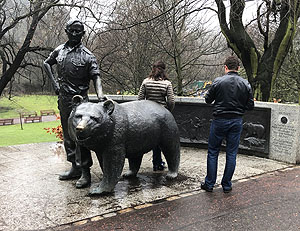
Just after Wojtek’s statue take the path left down the hill towards the large gold fountain and plaza. (the fountain is currently off being refurbished). At the bottom you can get another classic view of the Castle, keep going past the fountain and over the little railway bridge. Follow the path out of the gardens passing the statue of ‘Bum’, America’s version of Greyfriar’s Bobby.
2. The Grassmarket to the Castle.
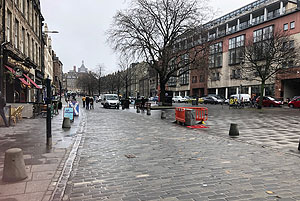 Turn immediately left, trying to avoid looking at the unsightly car park on your right. There really is not much to see here so scurry along this part, under the bridge with two impressive ‘Cleopatra Needle’ plinths and follow the road till it emerges at The Grassmarket.
Turn immediately left, trying to avoid looking at the unsightly car park on your right. There really is not much to see here so scurry along this part, under the bridge with two impressive ‘Cleopatra Needle’ plinths and follow the road till it emerges at The Grassmarket.
The Grassmarket was the main market area in Edinburgh, mostly for Cattle who entered the city from the opposite end via the ‘Cowgate’. The propensity of very old Taverns along this quarter is a clue to the number of cattle drovers and market traders who required liquid refreshment. Not much has changed in that respect and there are many bars and restaurants competing for your cash.
As well as a market this area also served as a place of public execution by hanging. Its worth taking some time to just soak in the atmosphere of this place and imagine the bustling market – the crowds gathering round the gibbet to see some local thief, murderer or other poor unfortunate (including over 100 covenanters) being set to swing for their crime. One such customer was the famous Maggie Dixon, A fishwife from Musselburgh who was accused of murdering her baby. She was hanged but as her body was being transported back to Musselburgh for burial she was suddenly jolted back to life. As the law only proscribed ‘hanging’ once as the punishment (the phrase ‘until dead’) was not included till later she had to be let go on the technicality that her punishment had been served. ‘Half Hangit Maggie’ is commemorated in the pub that bears her name.
At the end of the grass market it’s worth just carrying on a few yards to look down the Cowgate, a cavernous street with bridges passing over – this gives you a sense of the bizarre architecture of Edinburgh where streets pile on top of each other – the very first skyscrapers were built here. Just around the corner is the Grassmarket project, a community project that looks after homeless and those with drug problems. The Grassmarket project also runs a small cafe that is open to the public and serves excellent coffee and cake. You can also ‘pay it forward’ by purchasing a meal or just a drink that can be given to someone in need. This is a stark reminder that the social problems that have plagued this area of the city for centuries are still just under the surface.
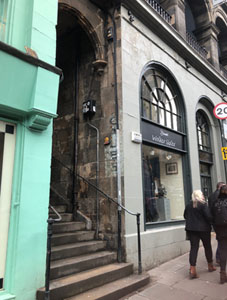
From the end of the Grassmarket take the winding road left, uphill called Victoria Street. This is possibly one of the most photogenic streets in the city. The street was one of the early ‘improvements’ to the claustrophobic and unhealthy old town. The street curves sensuously up towards George IV Bridge and has a unique double level on its North side.
About halfway up there is a small entrance on the left – easily missed – this was the original way from here up to the High Street. This is one of Edinburgh’s famous ‘Closes’. Steep and narrow streets that connect the high street with the lower levels. Take the stair up and double back to get a great view of the upper tier of Victoria Street and then continue back up towards the West Bow.
At the top of this connecting route we reach a cobbled roundabout of sorts, to your right the High Street or ‘Royal Mile’ falls away, to your left ‘The Hub’ A converted gothic church (also a good cafe). Take the fork to the right of The Hub (its sort of obvious by the crowds) and up towards the Castle.
3. Edinburgh Castle
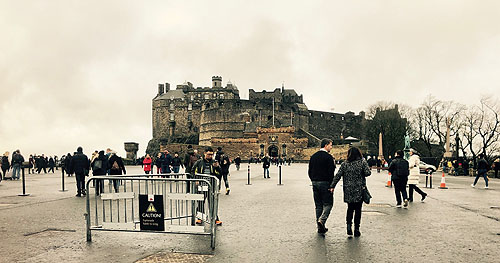
By now you have probably been teased long enough, all the way along you have caught little glimpses or spectacular views of the castle as this route winds around it, finally its time to go in. duck your head down and try to get past the crowds and onto the castle esplanade.
If you are here around the festival time then the esplanade will be pretty much taken up with a massive grandstand structure in place for the Tattoo, at the far end of the esplanade a drawbridge will take you into the Castle. Once tickets have been procured you can continue on.
You could easily fill a whole book on the castle alone and there are plenty available in the gift shop so I don’t really need to go into massive detail. Take time to enjoy the magnificent views from the ramparts – to the North, Princes Street and the New Town opens up – further on the River Forth and Fife. To the North West you can just make out the tops of the Forth Bridges and the Ben Lomond (yes you are more or less looking from one side of Scotland to the other). Over on the South side the city sprawls out with the Pentland hills in the distance. You can also get excellent views over to Arthurs Seat and the Crags.
Arthurs Seat is the remains of an extinct volcano and the castle is the plug of another one. Around 350 million years ago this whole area was fiercely volcanic. Volcanic plugs make very good defensive locations and Stirling Castle sits on a similar outcrop. The castle is really a collection of buildings that have grown organically over time. There are number of museums in the castle; The War memorial, St Margaret’s Chapel, Royal Scots Museum, Great Hall etc.
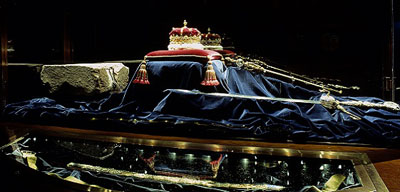
No visit would be complete without a visit to see the Scottish Crown Jewels and Stone of Destiny. The Scottish crown jewels known as ‘The Honours of Scotland were used to crown Mary’ Queen of Scotland and her Son James VI and Charles I. After the Act of union in 1707 the treasures were locked away and forgotten until Sir Walter Scott and accomplices rediscovered them. The Stone of Destiny or ‘Stone of Scone’ which forms part of the same display has an even more chequered past. There are lots of legends about the origin of the stone, used in the crowning of Scottish monarchs but geology suggests it came from the area near Scone Palace. King Edward I of England took the stone back to England as spoils of war and it was placed under the throne at Westminster palace where it was used in coronation ceremonies for every English and British monarch ever since. In 1996 the stone came back to Scotland but on the condition that it would be returned for any future coronations when required.
Another tradition in the castle is the One O’Clock Gun. It has been a long established practice to fire a canon at this time every day, except Sunday, Christmas and Good Friday and many a tourist is seen to jump in fright as the gun goes off. The gun is used as an intricate signal to ships in the port of Leith. Too far away to be heard, the sound would be picked up from the tower on Calton Hill (over to the east that looks like a telescope). On the top of the tower a ball was hoisted on a pole and dropped when the gun went off. Ships in the port would watch for the ball and could set their timepieces.
Scaring tourists since 1861 the gun is now a 25lb Howitzer. It has only ever once been used in anger when an attempt was made to shoot down a Zeppelin, raiding the city in 1916. An older piece of ordinance, Mons Meg is hard to miss. This monster of a canon dates back to 1449 and was given as a gift to James II. On the coronation of Mary, Queen of Scots one of the massive 150kg balls was fired in a salute. Soldiers retrieved the round by the river Forth 2 miles away.
The final word on cannonballs, as you leave the castle over the esplanade look at the building on the right – you will see a cannonball set into the wall here. Many a tour guide will tell you this was fired from the castle but this is a tall tale. The Ball actually marks the high water line for a water tower that used to stand opposite.
Its now time to run the tourist gauntlet of the Royal Mile.
4. The Royal Mile (part one)
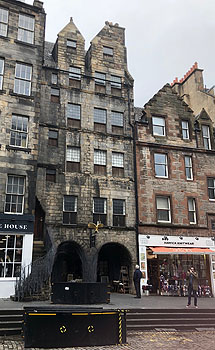
We’re going to take the Royal Mile in two chunks with a detour. Retrace your steps back down to the West Bow, Hovering Yoda’s, and all the other usual living statue types litter this narrow stretch. Two attractions; The Camera Obscura and Scotch Whisky Experience and worthwhile stops if you have time. After the West Bow look out for a tall townhouse on the left with a gold eagle on the outside. This is Gladstone’s Land – a preserved 17th century merchants house that would have been typical of houses of the time.
There are several museums on the Royal Mile – we will point them out and leave you to decide which are worth a visit and which ones you would leave for another day.
As you continue down you come to a large crossroads. on the left is the famous Deacon Brodies tavern. Named after the unscrupulous cabinet maker who was one of the Deacons of the trades guild by day and a housebreaker by night. Brodie was captured and hung for his crimes but his legend lived on when Robert Louis Stevenson, who’s father owned furniture made by Brodie used him as the inspiration for the character(s) of Dr Jekyll and Mr Hyde. At this crossroads take a right turn and head south.
5. Bridges, Greyfriars and Museum of Scotland
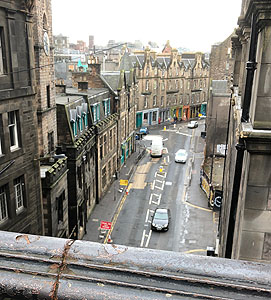 Head down the George IV Bridge. You are probably going to think ‘this doesn’t seem like a bridge’ but a few yards past the top of Victoria St (worth a photo stop to get the classic picture of this street) you will suddenly realise that you are a few hundred feet up as a gap in the buildings gives you a glimpse of the streets below. This remarkable lattice work architecture is fascinating and horrifying in equal measure because the narrative that can be derived from this is almost a perfect analogy of class division; up on top in the grand airy boulevard we have the Libraries and grand buildings but in the layers below street level were festering slums. Warrens of underground passageways connect old and new and almost an entire city full of people existed here. Mary King’s Close, a nearby tourist attraction was one such street. Closed over when the City Chambers were built sealed up, the street is now like a fly in amber, preserved as it was when the last occupants left. For now though keep going until you reach the statue of Greyfriars Bobby.
Head down the George IV Bridge. You are probably going to think ‘this doesn’t seem like a bridge’ but a few yards past the top of Victoria St (worth a photo stop to get the classic picture of this street) you will suddenly realise that you are a few hundred feet up as a gap in the buildings gives you a glimpse of the streets below. This remarkable lattice work architecture is fascinating and horrifying in equal measure because the narrative that can be derived from this is almost a perfect analogy of class division; up on top in the grand airy boulevard we have the Libraries and grand buildings but in the layers below street level were festering slums. Warrens of underground passageways connect old and new and almost an entire city full of people existed here. Mary King’s Close, a nearby tourist attraction was one such street. Closed over when the City Chambers were built sealed up, the street is now like a fly in amber, preserved as it was when the last occupants left. For now though keep going until you reach the statue of Greyfriars Bobby.
We all know the story of the wee faithful dog so he needs no introduction. The little bronze statue sits over a drinking well designed for dogs. A recent habit of tourists to rub the nose for luck (again I’m blaming the tour guides for this) has resulted in his poor nose being a little shiny and worn. The Local authorities spent a small fortune on special paint to protect it but its just as bad as ever. Take a photo (leave the nose alone) and cross the small road that leads back down to the grassmarket between the pub and the art shop you can find the entrance to Greyfriars Kirkyard.
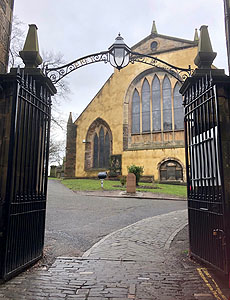
If you can only handle one cemetery on your trip it should be this one. It can be rather spooky and you will no doubt notice the skeleton carvings on walls, the skull and crossbones headstones etc. Grim as they are this ‘momento mori’ style is a reminder to all that we are mortal and no, it has nothing to do with pirates. The Kirk was where the national Covenant was signed here in 1638 and in 1679 some 1200 prisoners were held here (in a gated off area at the far corner on the left). Many died of starvation and exposure in this very place.
You will find the grave of Bobby and his master here along with many others, including the notorious Sir George MacKenzie a former lord advocate and person responsible for the awful treatment of those covenanter prisoners. The ghost of ‘Bluidy MacKenzie’ is thought to haunt the kirkyard as if some supernatural torment continues between him and those he persecuted. Many visitors have reported receiving cuts and bruises while visiting at night. In 2004 a couple of youths broke into the tomb and stole MacKenzies head and were caught playing with it in the graveyard. They were the first people in over 100 years to be charged in Scotland with Grave Robbing!
Hurry from the kirkyard and cross the road over to the Museum of Scotland.
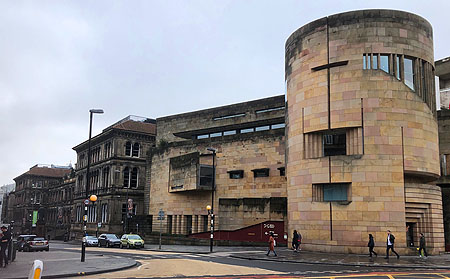
The Museum is really two buildings ingeniously stuck together, the Victorian Royal Museum and the modern Museum of Scotland. You can enter from either building but the Royal Museum entrance probably has more flair. A few years ago the museum was completely refurbished so the grand steps at the front go nowhere and that classic revolving door is no longer in use – Now one enters through low-key entrances at either side into a dark sub level, narrow stairs take you up into a grand three story glass vaulted atrium – one of the most grand public spaces in Edinburgh. There is so much light that even on the brightest of days it seems brighter in here than it does outside and the acoustics have a cathedral like feel. The Old Royal Museum has all the usual museum fare; natural history, costume, industry, archaeology etc. just off the main atrium a large and very quirky clock runs an hourly spectacle that is worth catching.
From the old museum a number of passages connect to the new Museum of Scotland next door. The design of the museum was very controversial at the time and Prince Charles resigned as patron due to the selection process of the winning design. Its certainly an acquired taste, brutalist in some areas and downright confusing in others. The space holds al the material relating directly to Scotland’s history so like it or not this is where most of the important stuff is.
There is so much material from prehistory to modern Scotland that it can be overwhelming but even if its just a little taste then it is a worthwhile visit – the museum isn’t going anywhere and despite having been here a thousand times i still see things I’ve never noticed before – after all she is a refined lady and doesn’t give it all out on the first date.
You might want to take a light refreshment here before stealing yourself for the rest of the Royal Mile.
6. The Royal Mile (part 2)
Head back along George IV bridge towards the Royal Mile and turn right at the lights – in a few yards the vista of St Giles Cathedral will appear ahead. With its unmistakable crown like spire this is ‘The Big Hoose’ for the Church of Scotland. A place of worship in one form or another for the last 900 years St Giles is the patron saint of Edinburgh and also Cripples and Lepers. Take just a brief moment to step inside St Giles if you can. You are standing at ground zero of one of the most turbulent periods in Scotland’s history.
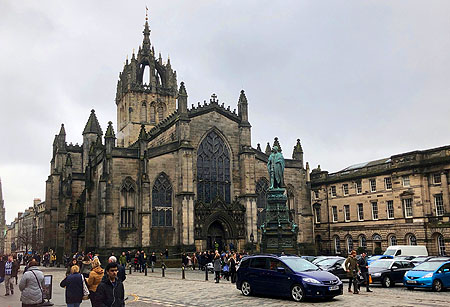
In 1559 the firebrand John Knox (more of him later) was installed as minister here. In 1637 Charles I introduced the Book of Common Prayer and the first sermon was read from it here on 23rd of July. The new book didn’t go down well and a local street vendor called Jenny Geddes threw her stool at the head of the minister, James Hannay. A riot ensued which led to the Signing of the National Covenant, this led to the Bishops Wars and then to the Wars of the Three Kingdoms and the English Civil War, Charles I among others lost his head and Scotland was thrown into a religious schism that one can argue we have never emerged from.
Take a moment to look at the exquisite carved tomb of The Marquis of Montrose and his arch enemy across the other side of the church Archibald Campbell of Argyll.
Outside St Giles be the edge of the road you will see a heart set out in cobblestones. This was the entrance to the old tollbooth prison and place of execution. There is a local tradition of spitting on the heart for good luck so on no account stand near the centre unless you want a spite shine on your shoes.
From St Giles its a pretty straight run down the Royal Mile, wider in this section the area is sort of half pedestrianised so can be confusing. During the festival this is the centre for street theatre so lots will be going on – you will also be harangued from every angle to go to some show or other and have leaflets thrust into your hand whether you want them or not. More dreadful tourist tat shops compete for your attention and overpriced food and drink is everywhere – Keep an eye out for the lovely mercat cross where proclamations were made.
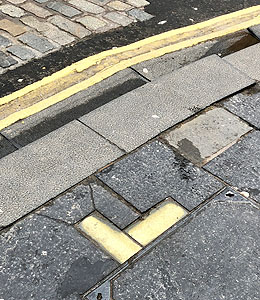 At yet another church and small public square there is a road intersection and the North and South Bridge Crosses the Street. This is a busy and narrow junction so take care and go straight over. A few yards down on the right is the Museum of Childhood, a small compact but charming collection of toys from every age. Further down to the left is John Knox house. Its questionable how much time John Knox lived here if at all but it is a fantastic example of a 15th century house. From here on the street does get narrow and can be very busy in season so take care. Just as you approach the next intersection look for the Worlds End pub on the right, now look down and try to spot the brass cobbles set in the street. These mark the boundary of the Flodden Wall and the Netherbow Port (one of the gates through the wall) The Flodden wall as the name suggests was built after the disaster at the Battle of Flodden in 1513. With the death of king James IV on the field townspeople feared an English invasion and the wall was built. The observant among you might have spotted a sign on the wall of Greyfriars kirkyard – that was the opposite side of wall.
At yet another church and small public square there is a road intersection and the North and South Bridge Crosses the Street. This is a busy and narrow junction so take care and go straight over. A few yards down on the right is the Museum of Childhood, a small compact but charming collection of toys from every age. Further down to the left is John Knox house. Its questionable how much time John Knox lived here if at all but it is a fantastic example of a 15th century house. From here on the street does get narrow and can be very busy in season so take care. Just as you approach the next intersection look for the Worlds End pub on the right, now look down and try to spot the brass cobbles set in the street. These mark the boundary of the Flodden Wall and the Netherbow Port (one of the gates through the wall) The Flodden wall as the name suggests was built after the disaster at the Battle of Flodden in 1513. With the death of king James IV on the field townspeople feared an English invasion and the wall was built. The observant among you might have spotted a sign on the wall of Greyfriars kirkyard – that was the opposite side of wall.
As you continue there are a few places to take a break from the busy street. The Peoples story Museum is a much underrated attraction that has lots on display that tells the story of everyday life in Edinburgh through the ages – This resides in the old Tollbooth – diagonally opposite the Museum of Edinburgh is also worth a quick drop in if you have time.
Eventually you will reach the foot of the Royal Mile (it really is about a mile) to your right the Scottish Parliament building and across the street and dead ahead is the place of Holyrood House. The Queens official residence when doing state duty in Scotland. Taking over 4 years to build and at a cost of over £400 million the Scottish parliament building splits opinion like no other building in Scotland. People either love it or hate it. Personally i think it is one of the most challenging and surprising pieces if architecture in Scotland. Bold and uncompromising in places but with subtle beauty, in particular the varied levels of the public spaces around the front that go from formal ponds to something akin to wild Scottish moorland. It also houses a very reasonable cafe if you need a break
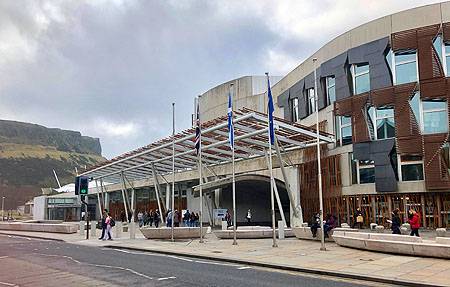
Crossing over takes you to The Palace of Holyrood House. The ruined abbey in the grounds was built in 1128 and a palace was first built here for James IV in 1505. the current palace was completed in 1678. Much of the palace is open to the public. The Royal apartments on the northwest corner were used as the residence for Mary’ Queen of Scots and it was here that David Rizzio, her private secretary was murdered in front of her by Mary’s husband Lords Darnley and his accomplices. The palace is said to be haunted by Bald Agnes a naked ghost of a woman who was stripped and tortured for witchcraft.
By now the sun might be getting low so time to start the return leg.
7. Calton Rd, Calton Hill and Back to the Start
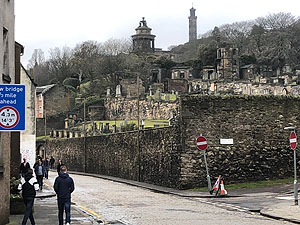
Work your way to the opposite corner of the roundabout and look for a narrow cobbled street called ‘Calton Road’ there is no complete pavement on the left so cross over – this isn’t a busy road but the pavement is narrow and traffic can be quite fast (or appear fast because of the cobbles). Its not a particularity attractive street so its best to duck out of it at the first opportunity – this happens to be the entrance to the New Calton Burial Ground, not particularly new by most standards this Classical themed graveyard is a shortcut up to Regent Road. This is a fairly steep climb but takes you quickly up to a better vantage point. If you don’t want to do this you can continue down Calton Road to the rear entrance of the station.
As you walk up through the cemetery look out for the watch tower over on the left – Watch towers like this were put in place around the time of the ‘resurrectionists’ or to give them their more popular term ‘body snatchers’. Villains who would dig up the bodies of the recently deceased and sell the corpses to the university medical shool for dissection. Burke and Hare are of course the most famous practitioners of the craft though they quickly moved from digging up the dead to just converting the living which was a lot easier work. The city installed watch towers to look out for grave robbers and you will see ‘table graves’ stones set flat on small legs to deter anyone digging them up. The watch towers didn’t last long though and changes in the law regarding the use of cadavers for medical research put an end to this vile trade.
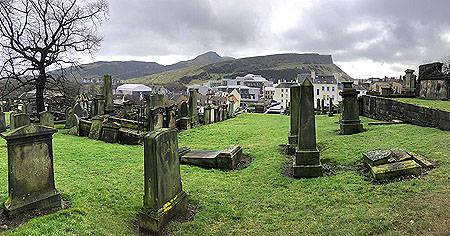
On reaching the street level at Regent road and catching breath turn left. A few yards ahead a large monument stands on your left side – this is Edinburgh’s official Robert Burns Monument. Though not as pompous as Sir Walter Scott’s and certainly not as large, Burns has the last laugh because next to Jesus and Queen there are more statues of Robert Burns worldwide than anyone else.
After taking in the monument you can now catch an excellent wide vista of the city, looking from Arthurs Seat on your left over to the Castle on the right. The area below you is less picturesque being mostly one large building site but progress has its price. looking ahead to the right you can see the Nelson Monument in Calton Hill – this telescope shaped building was the one we mentioned regarding the one o’clock gun. If anyone has any energy or time left then there is an entrance to Calton Hill just beyond the old Royal High School building on your right by the roundabout. On Calton hill you will find the National Monument, Also known as Scotland’s Disgrace this copy of the Parthenon was meant to celebrate Britain’s victory over Napoleon but the money ran out so only one side was erected. Also on Calton hill you will find the original Observatory of Edinburgh (currently being refurbished into an art gallery) and some excellent views down Princes St and over to Leith.
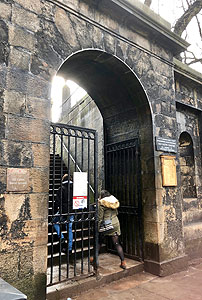 One final stop before you head home though. as you reach the roundabout head straight on (if you have not made the Calton Hill assault) go past the magnificent 1930 edifice of St Andrews House. Home of the Scottish Government. a high wall on your left is broken by a small gated entrance to old Calton Graveyard. This small cemetery houses a few surprises. a huge Cleopatra’s needle is a monument to political martyrs, here also lies Philosopher David Hume, one of the most important figures of the Enlightenment and our American visitors will be surprised to see a statue of Abraham Lincoln. This is the Scottish American Soldier’s Monument and is dedicated to Scots who fought during the American Civil War. It is the only monument to this war outside the USA and the first ever statue of a US president outside the USA. Exit the cemetery and turn left to continue on.
One final stop before you head home though. as you reach the roundabout head straight on (if you have not made the Calton Hill assault) go past the magnificent 1930 edifice of St Andrews House. Home of the Scottish Government. a high wall on your left is broken by a small gated entrance to old Calton Graveyard. This small cemetery houses a few surprises. a huge Cleopatra’s needle is a monument to political martyrs, here also lies Philosopher David Hume, one of the most important figures of the Enlightenment and our American visitors will be surprised to see a statue of Abraham Lincoln. This is the Scottish American Soldier’s Monument and is dedicated to Scots who fought during the American Civil War. It is the only monument to this war outside the USA and the first ever statue of a US president outside the USA. Exit the cemetery and turn left to continue on.
The large clock tower of the Balmoral Hotel will be right in from of you, The Duke of Wellington on Horseback points up the bridges over on your right, ignore his directions and head straight over the road, past the front of the swish Balmoral hotel with tartan concierges and you will find the entrance to station – head down the Escalators / steps to get back onto the station. If you have time or inclination for a quick drink then across the road between the Apple Store and Wellingtons statue a small lane will take you to the Guildford Arms or Cafe Royal just behind – classic Victorian pubs.
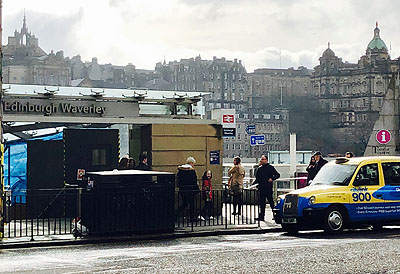
Conclusion.
My son and i walked this route today with one short Coffee stop and it took us just over 2 hours. Factor in that the Castle and main museum will probably take up maybe 2 hours each at least this route will give you a few extra hours to spare at the other points of interest. This will give you a great introduction to our city and hopefully make you want to come back and do all the bits you missed the first time. We hope it proves useful and is as much fun for you as it was for us just walking it.
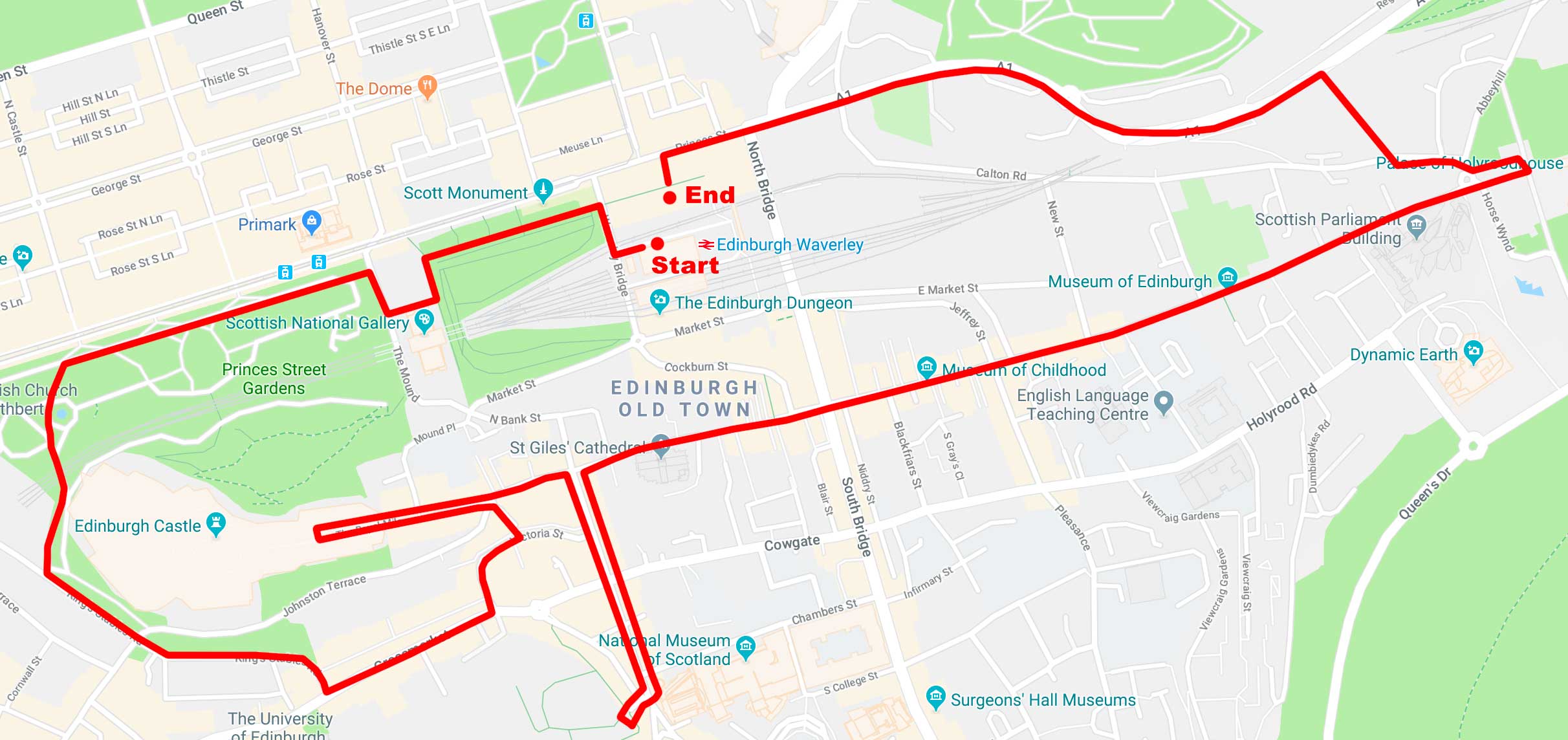
Distance Covered: 4 Miles (6.4km)
Follow this link to the Flikr gallery with photos we took on our route.
Rodger Moffet 2018

Didn’t see your map at the bottom and decided to plot this out on Google Maps myself as I went through the description. Had a blast following your route that way, and picked up some tips for my own future visit.
You should mention the Robert Louis Stevenson memorial near the garden fountain. More visitors will be familiar with that name than others in Edinburgh.
WOW! Fabulous tour for those of us who are too old to cross the pond to see these sights in person! Thank you for all the effort put force on our behalf!
Wonderful! I’m visiting Edinburgh in August and this looks like a super activity.